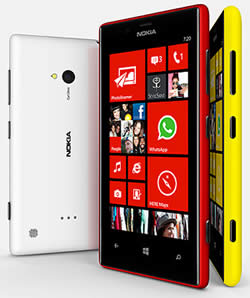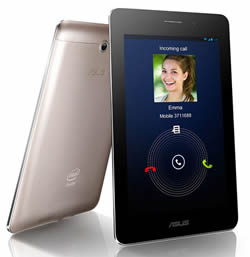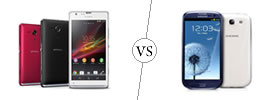Difference between Nokia Lumia 720 and Asus FonePad
Key Difference: The Nokia Lumia 720 is one of the newest phones that are similar to its flagship Lumia 920. The Lumia 720 comes with 1 GHz dual-core Snapdragon S4 processor with 512 MB RAM and 8 GB internal storage space that is upgradeable to 64 GB. The phone is available with a 6.7 MP primary camera with Carl Zeiss optics, autofocus and LED flash. It also has a 1.3 MP secondary camera with a resolution of 1280 x 960. Asus has announced the launch of newest phablet, the Asus Fonepad. The Fonepad is a 7-inch Android tablet that allows users to also make phone calls by placing the device on their ear. The phablet sports a 7-inch IPS LED backlit touch screen that allowed multitouch capability for up to 10 people. The screen has a resolution of 1280 x 800, which provides approximately 216 ppi density, a decent enough resolution.
 Nokia is a popular Finnish phone company and has been previously known for durability and increased battery life of phones. When it entered the smartphone market, it teamed up with Microsoft Windows for mobile and has been launching phones with their OS. The Nokia Lumia 720 is one of the newest phones that are similar to its flagship Lumia 920. The little brother is quite similar in looks and many features, lacking only the strikingly high price tag. Nokia has recently announced a number of low- to mid-range phones to try and capture the masses. The phone is being touted as one of the best phones for its price range. The phone sports a 4.3-inch IPS LCD capacitive touch screen, with approximately 217 ppi, which is a decent enough screen resolution. The phone comes with the standard Live Tiles format from the Windows 8.
Nokia is a popular Finnish phone company and has been previously known for durability and increased battery life of phones. When it entered the smartphone market, it teamed up with Microsoft Windows for mobile and has been launching phones with their OS. The Nokia Lumia 720 is one of the newest phones that are similar to its flagship Lumia 920. The little brother is quite similar in looks and many features, lacking only the strikingly high price tag. Nokia has recently announced a number of low- to mid-range phones to try and capture the masses. The phone is being touted as one of the best phones for its price range. The phone sports a 4.3-inch IPS LCD capacitive touch screen, with approximately 217 ppi, which is a decent enough screen resolution. The phone comes with the standard Live Tiles format from the Windows 8.
The Lumia 720 comes with 1 GHz dual-core Snapdragon S4 processor with 512 MB RAM and 8 GB internal storage space that is upgradeable to 64 GB. It also offers Corning Gorilla Glass 2 for protection purposes. The phone is available with a 6.7 MP primary camera with Carl Zeiss optics, autofocus and LED flash. It also has a 1.3 MP secondary camera with a resolution of 1280 x 960. The company offers many camera features such as touch focus, landscape orientation, auto and manual exposure, auto and manual white balance, still image editor, full screen viewfinder, Cinemagraph lens, Bing vision, Smart Shoot lens and panorama lens. The Smart Shoot lens allows the users to merge two different photos to create a perfect shot, which comes handy, if you don’t like having to tell people pose in front of the camera. The phone is slick and thin bar phone with slightly curved edges. The phone sports a 3.5mm jack on the top, with camera button, volume button and the sleep/wake button on the right hand side. The back also three tiny holes for a Wireless Charging cover, which fits on the back of the device. The phone is customizable with changing shells, making it easier to mix and match the phone with various different colors. The phone has been announced for the Australian market, with launch dates yet to be released for the rest of the world.
 Asus has announced the launch of newest phablet, the Asus Fonepad. The company states that the purpose of launching this phone is to bridge the gap between the phone and the tablet, eliminating the need for the carrying to separate devices. The Asus Fonepad is practically a tablet that has phone call making capabilities. The Fonepad is a 7-inch Android tablet that allows users to also make phone calls by placing the device on their ear. Some people may find it silly to place such a huge device on their ear to make calls; for those people the tablet does allow connectivity with a Bluetooth device.
Asus has announced the launch of newest phablet, the Asus Fonepad. The company states that the purpose of launching this phone is to bridge the gap between the phone and the tablet, eliminating the need for the carrying to separate devices. The Asus Fonepad is practically a tablet that has phone call making capabilities. The Fonepad is a 7-inch Android tablet that allows users to also make phone calls by placing the device on their ear. Some people may find it silly to place such a huge device on their ear to make calls; for those people the tablet does allow connectivity with a Bluetooth device.
The Asus Fonepad has borrowed a bunch of features from the Nexus 7, which was also created under Google and Asus collaboration. The weight, dimension and the display are all similar to the Nexus 7; however, the company has replaced the back. The plastic-leather back of the Nexus 7 has been replaced with a slick, steel casing. The device is available in titanium gray and champagne gold colors. The phablet sports a 7-inch IPS LED backlit touch screen that allowed multitouch capability for up to 10 people. The screen has a resolution of 1280 x 800, which provides approximately 216 ppi density, a decent enough resolution. Under the hood, the phablet runs on 1.2 GHz single-core Intel Atom processor, making it pretty fast for multi-tasking, along with playing some high-res games. The device has 1 GB RAM.
There will be two versions of the tablet, one for Europe, the other for Asia. The launch regarding rest of the World has yet to be revealed. The European variant will have 16 GB internal storage capacity, with no rear camera. However, the Asian variant will 8 GB internal storage capacity and will house a 3.2 MP rear camera. Both the variants will house 1.2 MP front camera for video conferencing. The phablet will not support 4G capabilities. The phablet will be available with preloaded Android v4.1 Jelly Bean, with no announcements yet regarding if it is upgradeable to the newest version. The internal storage capacity can expanded up to 32 GB using a MicroSD. One of the most prominent features of the phablet is the massive battery that has been mounted on the device. The non-removable Li-Ion 4270 mAh battery allows the phone to support 32.5 hours of talktime on 3G and 751 hours of standby time. There is no proper release date for the phone, with the expected release to be around April or May 2013.
The information for the detailed table about the two phones has been taken from the Nokia website, techradar.com, Asus website, trustedreviews.com, pcworld.idg.com.au and GSMArena.com.
|
|
Nokia Lumia 720 |
Asus Fonepad |
|
Launch Date |
April 2013 |
Expected April 2013 |
|
Company |
Nokia |
Asus |
|
Size |
127.9 x 67.5 x 9 mm |
196.4 x 120.1 x 10.4 mm |
|
Display |
4.3” IPS LCD capacitive touchscreen |
7" LED Backlight WXGA IPS Panel touch screen |
|
Screen |
480 x 800 pixels (~217 ppi pixel density) |
1280x800 (~216 ppi pixel density) |
|
Protection |
Corning Gorilla Glass 2 |
N/A |
|
Weight |
128 grams |
340 g |
|
2G Network |
GSM 850 / 900 / 1800 / 1900 |
GSM 850 / 900 / 1800 / 1900 |
|
3G Network |
HSDPA 850 / 900 / 1900 / 2100 |
WCDMA: 850/900/1900/2100 HSDPA 850 / 900 / 1900 / 2100 |
|
4G Network |
N/A |
N/A |
|
GUI |
Windows Phone 8 |
Asus UI |
|
CPU speed |
1 GHz Dual-core Snapdragon S4 processor. |
1.2 GHz Single-core Intel Atom |
|
GPU |
Adreno 305 |
PowerVR SGX540 |
|
OS |
Microsoft Windows Phone OS 8 |
Android OS v4.1 (Jelly Bean) |
|
Chipset |
Qualcomm MSM8227 |
Intel Atom Z2420 |
|
RAM |
512 MB |
1 GB |
|
SIM Size |
Micro-SIM |
microSIM |
|
Internal Memory |
8 GB |
8/16 GB |
|
Expandable Memory |
Up to 64 GB |
Up to 32 GB |
|
Sensors |
Orientation sensor, high brightness mode, sunlight readability enhancements, Ambient light sensor, accelerometer, proximity, compass |
GPS & Glonass,G-Sensor, E-compass, Proximity, Ambient Light Sensor |
|
Connectivity |
GSM, HSDPA, micro-USB, Bluetooth, Wi-Fi, NFC. |
GSM, HSDPA, WCDMA, Bluetooth, USB, WLAN802.11 |
|
Data |
GPRS, EDGE, WLAN, Bluetooth, NFC and USB. |
GPRS, EDGE, WLAN, Bluetooth, USB |
|
Speed |
HSDPA, 21.1 Mbps; HSUPA, 5.76 Mbps |
HSDPA 21 Mbps, HSUPA 5.76 Mbps |
|
WLAN |
Wi-Fi 802.11 a/b/g/n, dual-band; Wi-Fi hotspot |
WLAN802.11 b/g/n |
|
Bluetooth |
Bluetooth v3.0 with A2DP |
Bluetooth V3.0 |
|
USB |
microUSB v2.0 |
microUSB v2.0 |
|
Primary Camera |
6.7 MP Auto focus with two-stage capture key camera |
3.2 MP autofocus camera |
|
Secondary Camera |
1.3 MP 1280 x 960 pixels camera. |
1.2 MP |
|
Video |
720p@30fps |
720p |
|
Camera Features |
|
|
|
Sound Enhancement |
No |
Active noise cancellation with dedicated mic; Asus Sonice Master audio technology with MaxxAudio 3 by Waves |
|
Audio supported formats |
ASF, MP4, AAC, AMR, MP3, M4A, WMA, 3GP, 3G2 |
MP3/WAV/eAAC+ player |
|
Video supported formats |
MP4, ASF, WMV, AVI, 3GP, 3G2, M4V, MOV |
MP4/H.264/H.263 player |
|
Battery Capacity |
Non-removable Li-Ion 2000 mAh battery |
Non-removable Li-Ion 4270 mAh battery (16 Wh) |
|
Talktime |
2G: 23.4 hours 3G: 13.4 hours |
3G: 32.5 hours |
|
Standby Time |
3G: 520 hours |
3G: 751 hours |
|
Available Colors |
White, Red, Yellow, Cyan, Black |
Titanium Gray, Champagne Gold |
|
Messaging |
SMS (threaded view), MMS, Email, Push Email, IM |
SMS(threaded view), MMS, Email, Push Email, IM |
|
Browser |
HTML5 |
HTML5 |
|
Radio |
Internet Radio |
No |
|
GPS |
Yes, with A-GPS support and GLONASS |
GPS, A-GPS, Glonass |
|
Java |
No |
Yes, via Java MIDP emulator |
|
Additional Features |
|
|
Image Courtesy: nokia.com, asus.com









Add new comment